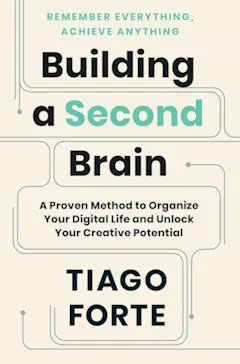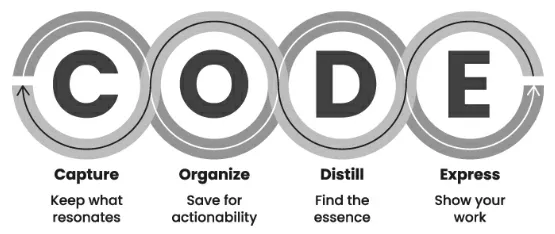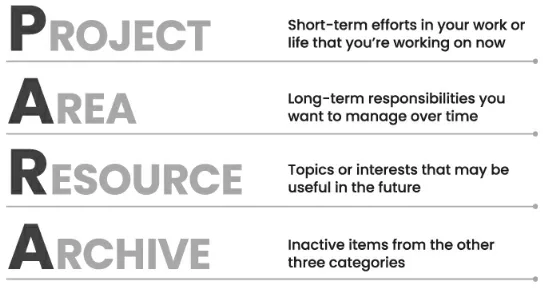Book: Building a Second Brain
The essence of the book Building a Second Brain by Tiago Forte: “progressive summarization” using excerpts from the book.1

Summary
- Proposes an approach to Personal Knowledge Management using a digital notebook as an extension of your brain
- When you come across something that resonates with you, capture it in a digital notebook
- Organize your notebook by projects and areas of interest so that the information becomes a) actionable for a current project or b) findable for a future project
- Distill the information to its essence to make it easy to browse and digest in the future
- Engage with the information to make it stick
- You shouldn’t do everything at once; you can make capturing information quick and painless and eventually organize and distill information in a regular session
CODE

Capture: Keep What Resonates
The solution is to keep only what resonates in a trusted place that you control, and to leave the rest aside.
Capture criteria:
- Does It Inspire Me?
- Is It Useful?
- Is It Personal?
- Is It Surprising?
Organize: Save for Actionability

- Projects: What I’m Working on Right Now
- Areas: What I’m Committed to Over Time
- Resources: Things I Want to Reference in the Future
- Archives: Things I’ve Completed or Put on Hold
Here’s the problem: the moment you first capture an idea is the worst time to try to decide what it relates to.
This order gives us a convenient checklist for deciding where to put a note, starting at the top of the list and moving down:
- In which project will this be most useful?
- If none: In which area will this be most useful?
- If none: Which resource does this belong to?
- If none: Place in archives.
Any piece of information (whether a text document, an image, a note, or an entire folder) can and should flow between categories.
Distill: Find the Essence
Every idea has an “essence”: the heart and soul of what it is trying to communicate.
Every time you take a note, ask yourself, “How can I make this as useful as possible for my future self?”
Progressive Summarization:

The effort we put into Progressive Summarization is meant for one purpose: to make it easy to find and work with our notes in the future.
Express: Show Your Work
To truly make an idea stick, you have to engage with it. You have to get your hands dirty and apply that knowledge to a practical problem. We learn by making concrete things—before we feel ready, before we have it completely figured out, and before we know where it’s going.
All these actions—evaluate, share, teach, record, post, and lobby*—are synonyms for the act of expression. They all draw on outside sources for raw material, they all involve a practical process of refinement over time, and they all end up making an impact on someone or something that matters to you.
Footnotes
-
Tiago Forte Building a Second Brain ↩